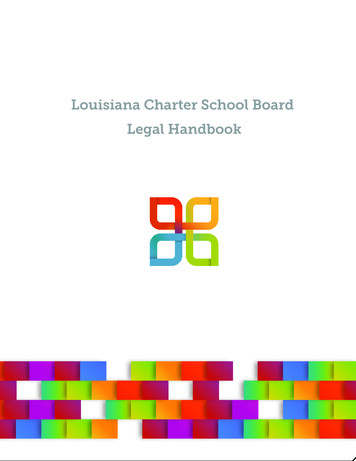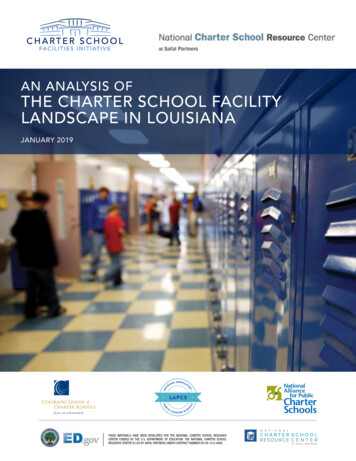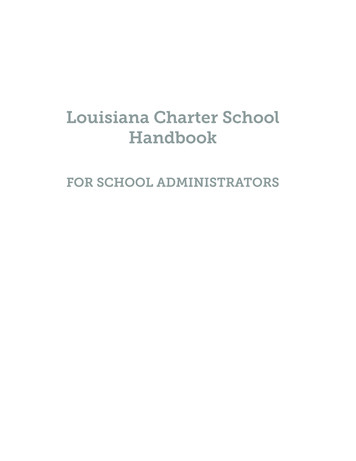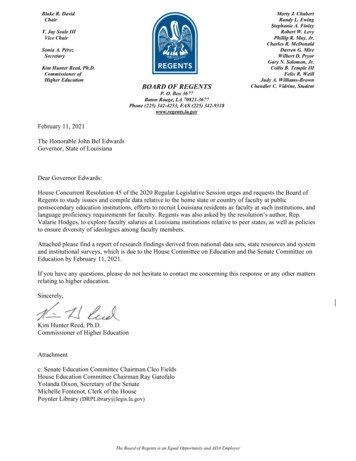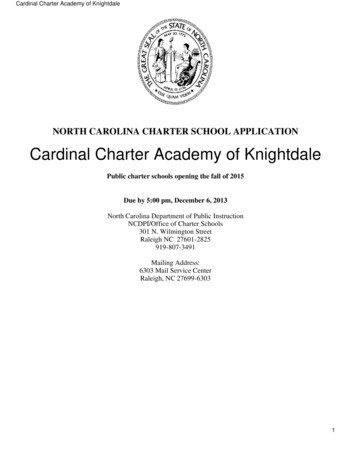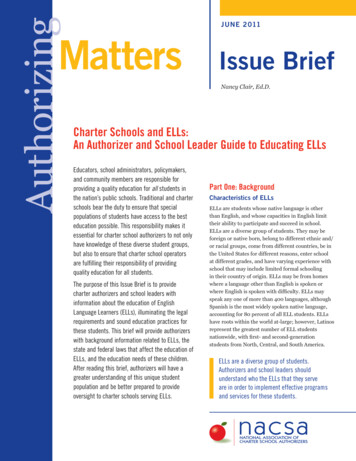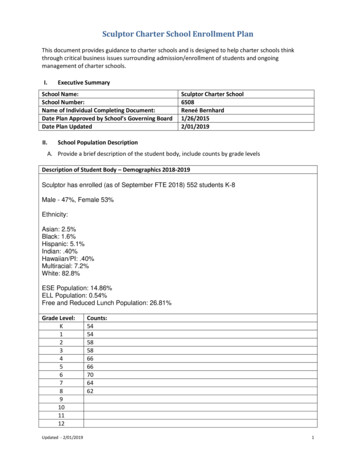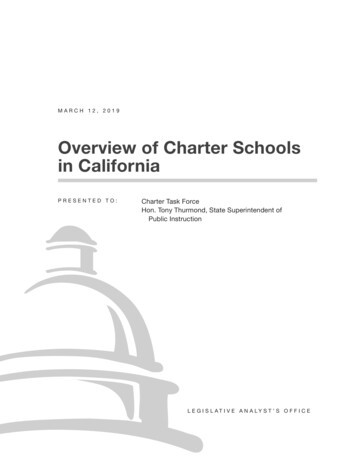
Transcription
March 2010Publication 324Charter Schools in Louisiana:What Lessons Do TheyHave to Offer the EducationCommunity?Public Affairs ResearchCouncil of LouisianaExecutive SummaryIn the past five years, the public education landscape has changed dramatically inLouisiana. A confluence of events created an opportunity to restructure schools that hadbeen failing for decades, particularly in New Orleans.In 2003, the state established the Recovery School District (RSD) as a mechanism to takeover failing public schools and turn them around. The move was not without controversy,but the prevailing sentiment was that the state needed to do something drastic to try toreverse the decline. What the state had not envisioned, however, was taking over schoolson the scale created by Hurricane Katrina’s devastation. In November 2005, almostthree months after Katrina struck, the state took control of more than 100 of the lowestperforming schools in Orleans Parish and transferred them into the RSD.Faced with the task of rebuilding a school system from scratch, the RSD turned to thecharter school model as a means to open several schools in a short period of time. Prior toKatrina, 18 charter schools operated in the state, including five in the RSD.Today, the RSD oversees 66 schools in Orleans Parish – 37 of which are charter schools.In addition, two state-authorized charter schools that predate Katrina operate in NewOrleans, as well as 12 charter schools overseen by the Orleans Parish School Board.At this point, more than 60 percent of the public school children in Orleans Parish arebeing educated in 51 charter schools. Outside New Orleans, 26 charter schools operate in12 other school districts, including 11 schools supervised by the RSD. The early resultsof this shift in public education delivery show promise as evidenced by increasing testscores, but the sustainability of this extensive network of charter schools remains aquestion.Given the state’s decision to support charter schools as a tool to help improve the qualityof public education in Louisiana, the Public Affairs Research Council undertook a studyaimed at identifying best practices among the existing charter schools in an effort todetermine which practices could be replicated in traditional public schools and in newcharter schools. This study does not attempt to assess the academic performance of thecharter schools in any depth, in large measure because the majority of the schools haveonly been open for a few years. However, the study does draw a connection betweenimproving test scores and the best practices these schools have implemented.The goal of identifying these best practices is to encourage to state to get the maximumbenefit from the lessons being learned. While even the most enthusiastic proponents
Lessons from Louisiana Charter Schoolsof charter schools acknowledge the limitations of the movement, it is PAR’s hope thatlessons drawn from this study can be disseminated to districts and schools across thestate and, in the process, have a broader impact on public education.The data revealed a number of best practices that could be grouped into five categories. Establishing a learning environmentBest practices: clearly defined academic expectations, clearly defined behavioralexpectations, a rewards or incentive system to encourage good conduct, unitybuilding events, parental involvement initiatives, calm and encouragingatmosphere Data-driven instructionBest practices: clearly defined assessment structures, mandatory tracking andanalysis of data generated from assessments, intervention plans Student enrichmentBest practices: extended school days, extended school years, Saturday programs,summer programs, non-academic activities, field trips Teacher support and developmentBest practices: Informal and formal observations of classrooms, administrativeand peer feedback, regularly scheduled planning periods, regularly scheduleddepartment/grade level meetings, regularly scheduled faculty meetings,professional development Policy-focused governing boardsBest practices: formal process for selecting new board members, diversity of skillsamong board members, clearly defined process for evaluating school leader,succession planning, formal board trainingAll of these best practices can be replicated in both traditional public schools andnew charter schools, but they are labor-intensive and require a significant amountof organization and preparation before they can be implemented. Then they requireongoing monitoring and adjustment. In addition, these best practices will only producethe desired results if every administrator, faculty member and staff member supportsthem and is diligent about following them. In general, Louisiana’s charter schoolsare better positioned to implement these best practices because of their autonomyand flexibility, their willingness to try different ways of running everything from theclassroom to the lunchroom, their smaller class sizes and their ability to let people go forlack of commitment to the school’s methods and culture.It is not impossible for traditional public schools to implement these practices, however.A former Teach for America member who taught in both a traditional public school anda charter school is now a principal in a traditional public school. She has been able toput some of the best practices related to establishing a learning environment and datadriven instruction into effect because she has a sympathetic district superintendent. TheRSD also has implemented a number of the best practices described here in its directrun, or traditional, public schools.Public Affairs Research Council of Louisiana2March 2010
Lessons from Louisiana Charter SchoolsThe problem is that information about these practices tends to be exchanged primarilyamong those in the charter school community. At the same time, local school districtsgenerally are suspicious of, if not hostile toward, charter schools. That makes it difficultto engage in a public dialogue about which practices are working well and which lendthemselves to replication in traditional public schools. In light of this, PAR makes thefollowing recommendation:Recommendation 1: The state Department of Education should create an advisorycouncil to conduct ongoing analysis of best practices in Louisiana charter schoolsthat can be replicated in traditional public schools and help develop guidelinesfor how these best practices might be implemented. Further, the council shouldprepare an annual report for dissemination among all local school districts.The data also showed some areas of ongoing concern for charter schools, includingfunding, facilities, community outreach and transparency. Transparency, in particular,is a concern because it refers to the ease with which the public can access informationabout existing and proposed charter schools. Unfortunately, the charter school landscapein Louisiana remains difficult for many parents to navigate. Therefore, PAR has tworecommendations to enhance the transparency of charter schools:Recommendation 2: The state Department of Education should maintain a Website with an accurate and easily accessible inventory of charter schools statewide,along with copies of their charters, amendments to those charters, the process forthird-year performance evaluations and for charter renewals, and summary budgetdocuments, to ensure maximum transparency in the expenditure of public dollars.In addition, the Web site should provide links to all of the charter schools’ Websites.Recommendation 3: State law should require each charter school to have a Website that provides such information as the school’s physical address, phone numberand name of a specific contact person; a list of administrators, faculty and staff,and their work contact information; a list of governing board members, and thetime and place of all of their meetings for the school year; and the agendas forall board meetings so that parents and other interested parties will know aheadof time what is to be discussed. In addition, each school should provide a clearexplanation of its admission requirements, if there are any, and a step-by-stepexplanation of how to register.Two substantive questions remain unanswered in the ongoing charter school experimentin Louisiana. Are charter schools making significant, long-lasting improvements in theirstudents’ performance, and how sustainable are charter schools themselves?On the question of how well charter schools are educating their students, the best wayto gauge their performance would be to follow a cohort of students from kindergartenthrough 12th grade. Some data already exist from the state’s original charter schools,i.e., those that have been in operation since before Katrina, and they indicate that mostof the schools are helping their students reach state performance targets.However, limited performance data exist for the Type 5 charter schools, which is thedesignation for charter schools formed under the jurisdiction of the state Board ofPublic Affairs Research Council of Louisiana3March 2010
Lessons from Louisiana Charter SchoolsElementary and Secondary Education (BESE) and supervised by the RSD. It will takemore time to determine whether the Type 5 charter schools are achieving their goalssimply because the oldest ones only began operating in 2004-2005.In terms of sustainability, success will depend on the resolution of problems in suchareas as funding, facilities, community relationships and transparency. Almost all ofthe funding for charter schools in Louisiana comes from public money – federal, stateand local. However, it is generally not enough to pay the costs of educating the schools’students. Any additional money, therefore, must come from private fundraising efforts,and some charter schools are more successful at that than others.The question of facilities continues to be a difficult one. The problem is that there simplyare not enough available buildings to meet the demand, and those that are availablefrequently require significant renovation and maintenance, both of which are difficult forcharter schools operating with limited budgets.Community support is another important factor for charter schools, particularly whenit comes to the Type 5 charter schools, which are the takeover schools. School leadersoften must try to diffuse the emotional backlash from the surrounding neighborhoodsbecause parents and students feel that their schools have been taken away from them.That makes it important for charter school officials to build relationships with theirneighbors.Lastly, there are concerns about transparency, or how easy it is for the public to accessinformation about charter schools in Louisiana.One possible solution to the question of sustainability may be the creation of smallclusters, or networks, of charter schools. The best known such network is the AlgiersCharter Schools Association, which has nine schools on the West Bank of New Orleans.The association’s small central office coordinates such things as transportation, foodservices, maintenance and human resources for all of the schools. In that way, theassociation is able to take advantage of economies of scale for needed services and giveits principals more time to focus on curriculum and instruction. Other small networksin New Orleans include the four KIPP charter schools and the two FirstLine Schools(Green and Ashe charter schools). In addition, Advance Baton Rouge has four charterschools in East Baton Rouge Parish and one in Pointe Coupee Parish.The charter school experiment is just underway in New Orleans and in the state as awhole. The early indications are that it is succeeding in bringing student achievementup, but more time is needed. The research here has identified some best practicesthat can help increase the chances for success among Louisiana’s charter schools.Further, these best practices do not have to be unique to charter schools; they can beimplemented in any school and in any district where a willingness to try new ideasexists. The state should take advantage of this opportunity and growing public supportto encourage all public schools to adopt those best practices that might work for them.Charter school proponents believe firmly that charter schools are not a panacea for whatails public education in Louisiana and the United States. However, the charter schoolmodel is a viable and valuable option in the arsenal of public school choices available todistricts and parents and a valuable resource in developing and trying out new tools tobreak the cycle of poor student performance.Public Affairs Research Council of Louisiana4March 2010
Lessons from Louisiana Charter SchoolsSome schools are improving more slowlythan others, including the two alternativeschools set up to serve students with specificneeds, but overall the numbers show thatmore progress is being made in studentachievement now than prior to Katrina.IntroductionCharter school – an independent public schoolthat provides a program of elementary and/orsecondary education established pursuant toand in accordance with the provisions of theLouisiana Charter School Law to provide alearning environment that will improve pupilachievement.Outside New Orleans, 26 charter schoolsoperate in 12 other school districts. Of those26, 11 are under the supervision of the RSD.Given the state’s decision to support charterschools as a tool to help improve the qualityof public education in Louisiana, the PublicAffairs Research Council undertook a studyaimed at identifying best practices amongthe schools in an effort to determine whichpractices could be replicated in new charterschools and in traditional public schools.This study was not designed to assess theacademic performance of charter schools inLouisiana.Traditionally, public education has notbeen Louisiana’s strong suit. For years, onlist after list, the state has ranked at ornear the bottom when it comes to studentperformance. And leading Louisiana inthis headlong charge to the bottom was theOrleans Parish public school system, whichconsistently was rated one of the worstperforming school districts in the nation.After Hurricane Katrina struck in August2005, the public education landscape inNew Orleans, and in Louisiana, changeddramatically. In November 2005, the stateof Louisiana took control of more than100 of the lowest performing schools inOrleans Parish and transferred them intothe Recovery School District (RSD). TheOrleans Parish School Board was left withoversight of five high-performing schools –that number has since dropped to four – and12 charter schools, 11 of which had beentraditional public schools or Citywide AccessSchools (magnet schools) before Katrina.Data for the study were collected duringvisits to 19 of the 77 charter schools (seeAppendix A) operating in Louisiana andduring interviews with principals, teachers,board members and parents directly involvedwith those schools. The majority of the sitevisits – 10 – were to schools in New Orleans.Six schools in East Baton Rouge Parish werevisited, and the other three visits occurredat schools in Avoyelles Parish, LafourcheParish and Plaquemines Parish.In addition, interviews were conductedwith more than a dozen people involved inthe larger charter school community. Theyrepresented such groups as the LouisianaAssociation of Public Charter Schools, NewSchools for New Orleans, Educate Nowand the state Department of Education’sOffice of Charter Schools, as well as otherorganizations and charter school networks.In total, nearly 75 people were interviewed.Finally, other research reports, documentsand newspaper articles focusing on charterschools at both the state and national levelwere examined.Over the past four years, the RSD hasreopened approximately two-thirds of thepublic schools in Orleans Parish. Today, theRSD oversees 66 schools in Orleans Parish –37 charter schools and 29 traditional publicschools. In addition, two state-authorizedcharter schools that predate Katrina operatein New Orleans today.At this point, more than 60 percent of thepublic school children in Orleans Parish arebeing educated in 51 charter schools. Theearly results of this shift in public educationdelivery show promise as evidenced byincreasing test scores (see Appendix A), butthe sustainability of this extensive networkof charter schools remains a question.Public Affairs Research Council of LouisianaThe information gleaned from the researchthen was entered into a qualitative dataanalysis software program and examinedfor commonalities, differences and any5March 2010
Lessons from Louisiana Charter Schoolsother information that could help guide thestudy and its conclusions. The data revealeda number of best practices that could begrouped into five categories – establishinga learning environment, data-driveninstruction, student enrichment, teachersupport and development, and policy-focusedgoverning boards – and resulted in threerecommendations for action.believe is crucial because one of the biggestcriticisms of traditional public schoolsystems is that they often become havens forincompetent teachers and administrators.Charter school operators may or may nothave admissions criteria for their students.In Louisiana, which has five differentcategories, or types, of charter schools (seeTable 1), the law permits those schoolsin Types 1, 2, 3 and 4 to have admissionsrequirements as long as the requirementsare specified in the school’s charter, theschool’s charter authorizer approves therequirements, and the requirementsare relevant to the school’s role, scopeand mission. In addition, the admissionrequirements cannot be used to exclude anystudent on the basis of race, religion, gender,ethnicity, national origin or intelligencelevel. Only charter schools in the Type 5category must have open admissions.Before explaining the findings in moredetail, a little background on charter schoolswill help give the study some context.Whatare charter schools?Charter schools are independent,autonomous public schools operated bynonprofit organizations that apply to acharter school authorizer for permissionto open a school. As autonomous entities,charter schools are not bound by the samerules that govern traditional public schools.Across the United States, several typesof authorizers exist: local school boards,state education agencies, higher educationinstitutions, independent chartering boardsand mayors/municipalities. In Louisiana,only local school boards and the state Boardof Elementary and Secondary Education(BESE) may approve charters.In exchange for the freedom to run theirschools as they see fit, charter schooloperators agree to meet state and localeducational standards. If they fail to meetthese goals within a specified period of time– often five years – their charters may not berenewed or may be revoked.Charter schools have existed in the UnitedStates for roughly 19 years. The first charterschool law was passed by Minnesota in1991, and the first charter school openedin 1992. Today, there are more than 4,500charter schools in 39 states and the Districtof Columbia and about 1.4 million studentsenrolled in them. Despite the amount ofattention given to charter schools in thepast few years, the number of students theyserve accounts for only about 3 percent of thetotal number of public school children in theUnited States.Charter schools were conceived of as analternate way to educate at-risk childrenwho were being failed by the country’straditional public education system.The premise was that all children couldlearn, but that at-risk children neededmore attention and more resources thanthey typically received in a traditionalpublic school. In addition, charter schoolproponents believe firmly that the academicexpectations for disadvantaged childrenshould be just as high as they are for affluentstudents and that it is not unreasonable toexpect their students will go on to college.Louisiana’s charter school law dates from1995 when legislators approved a pilotprogram designed to allow up to eight schooldistricts to set up charter schools. In 1997,legislators rewrote the law to permit charterschools in all school districts and to establishfour categories of charter schools (see Table1). Since then, lawmakers have created afifth category of charter school for use byCharter school operators are free to organizetheir curricula however they wish, usewhatever textbooks or teaching materialsthey prefer, and hire and fire faculty andstaff as needed. It is this latter componentthat many in the charter school movementPublic Affairs Research Council of Louisiana6March 2010
Lessons from Louisiana Charter SchoolsTable 1. Charter School Types, DescriptionsTypeDescriptionType 1A start-up school authorized by the local school board. Only students who live in the local school district are eligibleto attend. The charter school may have admission requirements. There are five Type 1 charter schools in Louisiana.Type 2A start-up school or a conversion of a pre-existing school authorized by BESE. Any student living in the state iseligible to attend. The charter school may have admission requirements. There are 11 Type 2 charter schools inLouisiana.Type 3A conversion of a pre-existing school authorized by the local school board. Students who live in the pre-existingschool’s attendance zone have first preference for enrollment, followed by any student living in the local schooldistrict. The charter school may have admission requirements. There are nine Type 3 charter schools in Louisiana.Type 4A start-up school or a conversion of a pre-existing school authorized by BESE where the local school board isthe applicant. Only students who live in the local school district are eligible to attend unless the district has set upattendance agreements with other school districts. The charter school may have admission requirements. Thereare four Type 4 charter schools in Louisiana.Type 5A conversion of a pre-existing school that has been taken over by the Recovery School District. BESE mustauthorize the charter. Only students who live in the local school district are eligible to attend. The charter schoolmust be open admission. There are 48 Type 5 charter schools in Louisiana.SOURCE: Louisiana Revised Statutes 17:3973the Recovery School District, eliminatedthe cap on the number of charter schoolsallowed to operate in Louisiana, imposedan administrative fee on charter schooloperators that is to be paid to local schooldistricts and mandated third-party review ofall charter school applications, among otherthings.opened and closed between 1996 and 2009.The most recent school to close was NewOrleans Free Academy. Its board of directorsvoluntarily shut the school down at the endof the 2008-2009 school year because of theschool’s inability to make sufficient academicprogress.TheAs noted previously, 77 charter schoolscurrently operate in the state, withapproximately 15 more charter schoolsapproved for the 2010-2011 and 2011-2012school years. In addition, more charterschools could be approved for the 2011-2012school year because another applicationperiod will be available later this year. Themajority of charter schools in Louisiana –51 – are in Orleans Parish. Thirteen operatein East Baton Rouge Parish, and the other13 are scattered throughout the state fromCaddo Parish to Plaquemines Parish (seeTable 1). The bulk of charter schools in thestate (48) are Type 5 charter schools and areunder the supervision of the RSD. The oldestcharter school in Louisiana is the JeffersonCommunity School in Jefferson Parish. Itopened in the 1996-1997 school year and isstill operating.The goal of this study was to determine whatpractices among the charter schools couldbe replicated in both new charter schoolsand in traditional public schools. Fiveareas emerged from the data: establishinga learning environment, data-driveninstruction, student enrichment, teachersupport and development, and policy-focusedgoverning boards.Best practicesEstablishing alearning environmentA school’s learningenvironment – orschool culture – isone of the keys todriving studentachievementin the charterschools examinedhere. In general,a successfullyestablishedschool culturemeans a calm,Prior to Hurricane Katrina, 18 charterschools operated in the state. Post-Katrina,59 others have opened, including 12 that arein their first year of operation in 2009-2010.In addition, 11 other charter schools havePublic Affairs Research Council of Louisianafindings7 Clearly definedacademicexpectations Clearly definedbehavioralexpectations A rewards orincentive systemto encourage goodconduct Unity-building events Parentalinvolvementinitiatives Calm andencouragingatmosphereMarch 2010
Lessons from Louisiana Charter SchoolsTable 2. Per-pupil funding amount (Fiscal Year 2009-2010)ParishPer-Pupil AmountParishPer-Pupil AmountAcadia 7,020Orleans1 7,837Allen 9,148Ouachita 8,522Ascension 8,255Plaquemines 11,315Assumption 9,165Point Coupee1 8,346Avoyelles 6,518Rapides 7,901Beauregard 8,698Red River 9,939Bienville 11,670Richland1 8,341Bossier 7,953Sabine 8,69311Caddo 8,229St. Bernard 8,426Calcasieu 8,344St. Charles 12,178Caldwell 8,299St. Helena 7,926Cameron 12,799St. James 10,760Catahoula 7,640St. John the Baptist 8,804Claiborne 9,602St. Landry 7,173Concordia 8,048St. Martin 7,627DeSoto 9,413St. Mary 8,516East Baton Rouge 8,963St. Tammany 9,206East Carroll 7,809Tangipahoa 7,187East Feliciana 7,938Tensas 8,937111Evangeline 7,885Terrebonne 7,637Franklin1 7,679Union1 8,144Grant 7,157Vermillion 7,226Iberia 8,286Vernon 7,441Iberville 9,630Washington 8,181Jackson 9,394Webster 8,444Jefferson1 8,318West Baton Rouge 9,116Jefferson Davis 8,953West Carroll 7,582 10,116Lafayette 7,827West FelicianaLafourche1 8,116WinnLaSalle1 8,790 8,4281City of Monroe 8,724Lincoln 8,667City of Bogalusa 9,324Livingston 7,574Zachary Community 8,614Madison 9,994City of Baker 10,101Morehouse 8,775Central Community 7,078Natchitoches 8,245SOURCE: Louisiana Department of Education Web site1orderly environment in the school whereteachers are able to concentrate more oninstruction rather than discipline. A clearlydefined, clearly explained, clearly visibleschool culture focuses on both academicand behavioral expectations. It also uses arewards or incentive system to encouragegood conduct and unity-building events tocreate camaraderie among students andfaculty. In addition, a successful schoolPublic Affairs Research Council of LouisianaDistrict has at least one charter school.culture includes an emphasis on parentalinvolvement.Depending on whether the school is anelementary or high school, the academicexpectations generally revolve aroundstudents scoring well on state-mandatedtests, being accepted into a high-quality,high-performing high school, going on tocollege, or completing a career track program8March 2010
Lessons from Louisiana Charter Schoolswith the appropriate certification andimmediately entering the job market.The KIPP schools use a “weekly paycheck”system under which students accumulatepoints for good behavior and lose them forbad behavior. The idea behind the systemis to teach the students that their behavioris something they can control and to teachthem that there are good choices and badchoices and consequences for each.The second component of a school culture iswhat behavioral expectations are in placefor students. School officials indicated thatthe behavioral expectations are equally as,if not more, important than the academicexpectations. The concept is simple. In orderfor effective learning to take place, the schoolenvironment must be calm and orderly, notchaotic. Accomplishing that, however, isdifficult because many of the students servedby charter schools come from backgroundswhere they are not accustomed to havingto control their behavior. As a result,administrators and faculty go to greatlengths to instill codes of conduct in theirstudents and to reinforce the behavioralexpectations.Parental involvement is another facet ofschool culture, but one that the charterschools have had difficulty with. A few ofthe schools in this study strongly encourageparental volunteer work once a child isenrolled, such as Lake Forest ElementaryCharter School. The school has a ParentalInvolvement Contract under which parentsagree to pick up their children’s reportcards, make sure their children follow therules and regulations, and agree to providefive hours of volunteer service at the schoolper family during each academic year. Atthe same time, state law says that charterschools cannot require parental involvementas a condition of enrollment, nor can theypenalize students whose parents choose notto get involved.They do this through a variety of methods,including the use of different types ofincentive systems that reward students forgood behavior and set up consequences forbad behavior. Other methods include a dailyassembly at which students are recognizedfor their accomplishments, special events onFriday afternoons, such as free ice cream orpizza, or a regularly scheduled school storeperiod during which students can buy thingswith the points they have earned throughtheir good behavior.Green Charter School has tried to engageparents through such things as its OpenGarden Day or Family Dinner Night. AtNew Orleans College Prep, administratorswere delighted when 350 parents turned outfor an orientation session on the Saturdaybefore school started this past fall. And atPrescott Middle School in Baton Rouge,a group of fathers comes to the schoolregularly to help out. Despite these effortsto encourage parental involvement, schoolleaders say they have had only limitedsuccess.At Samuel J. Green Charter School andArthur Ashe Charter School in New Orleans,administrators and teachers use a “BenefitBucks” system where students earn “Bucks”for good behavior. They can
Lessons from Louisiana Charter Schools Public Affairs Research Council of Louisiana March 2010 of charter schools acknowledge the limitations of the movement, it is PAR's hope that lessons drawn from this study can be disseminated to districts and schools across the state and, in the process, have a broader impact on public education.


